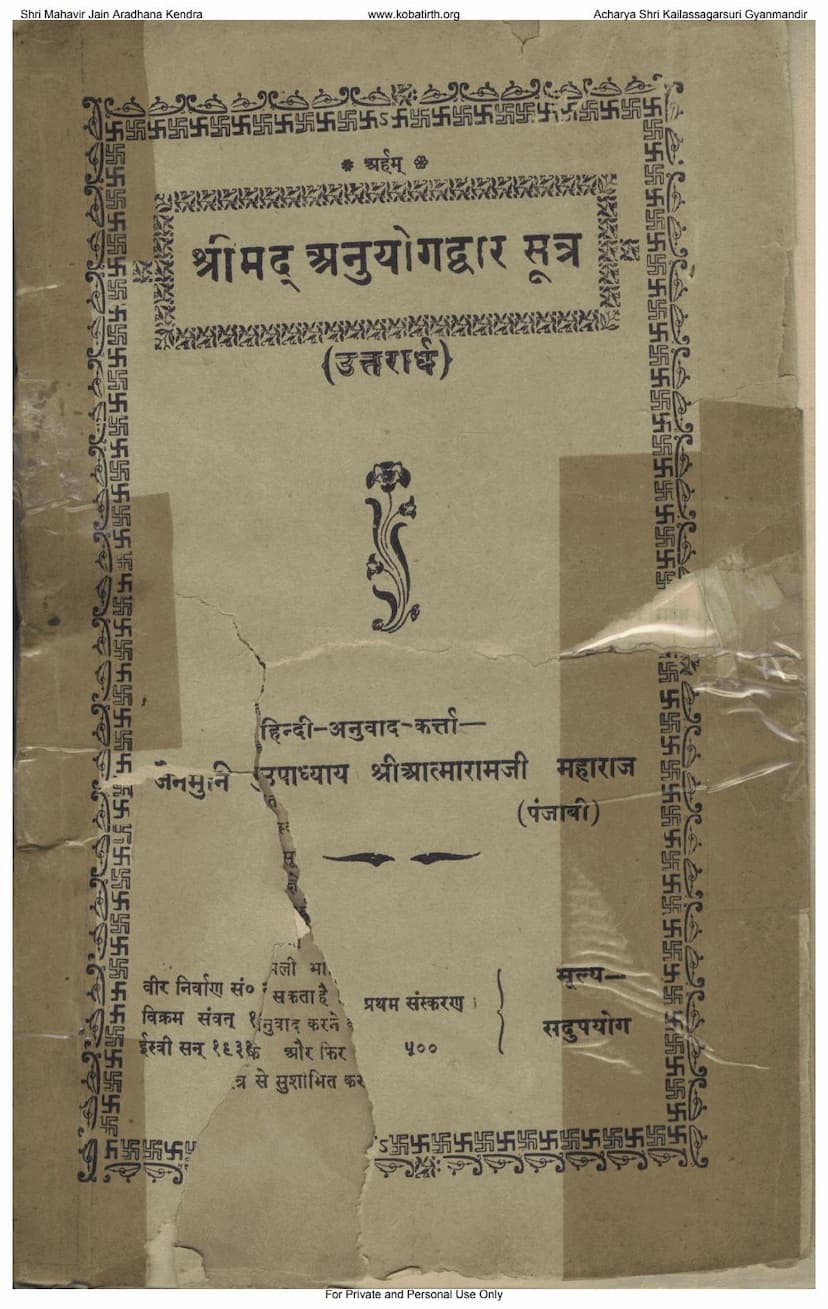Anuyogdwar Sutram Uttararddh
Added to library: September 1, 2025

Summary
This is a summary of the Anuyogdwar Sutram Uttararddh (the latter half of the Anuyogdwar Sutra), authored by Acharya Shri Atmaramji Maharaj.
The text is a detailed exposition of various aspects of Jain philosophy and practice, presented in a question-and-answer format, primarily between Lord Mahavir and Lord Gautam Swami. The summary covers the following key areas:
1. Pramana (Means of Knowledge): The text begins by defining "Pramana" as the means by which things are measured or understood. It elaborates on the four types of Pramana: * Dravya Pramana (Substantial Measure): Discusses substances in terms of their constituent parts (pradesha) and their divisions. * Kshetra Pramana (Spatial Measure): Explains spatial measurements using units like angul, hasta, kosha, and yojana. It details the dimensions of various entities and realms within the Jain cosmology. * Kaal Pramana (Temporal Measure): Defines time through units like samay, avalika, muhurta, dina, ratri, paksha, masa, varsha, yuga, palya, sagara, and their interrelationships, illustrating the vast scales of time in Jainism. * Bhava Pramana (Modal Measure): Explains modes and qualities, focusing on qualities like color, smell, taste, touch, and form (samsthana). It details the variations in these qualities within living beings and substances.
2. Naya (Standpoints/Perspectives): The text extensively discusses the seven Nayas (standpoints) crucial for understanding Jain philosophy, illustrating each with analogies: * Naigama Naya: Deals with the general or absolute aspect, often seen in the context of the initial purpose. * Sangraha Naya: Focuses on the general or collective aspect, emphasizing commonalities. * Vyavahara Naya: Represents the conventional or practical standpoint, dealing with worldly classifications and usage. * Rijusutra Naya: Emphasizes the present moment and the direct, linear flow of time and causality. * Shabda Naya: Prioritizes the literal meaning of words. * Samabhirudha Naya: Interprets words based on their commonly understood meanings and context. * Evambhuta Naya: Focuses on the actual state or form of a thing at a particular moment, emphasizing the "is-ness" of a phenomenon.
3. Pustaka (Measurement & Counting): A significant portion is dedicated to various types of measurements and numerical quantities: * Measurements of Grain and Liquids: Details traditional units for measuring grains (like prasriti, kudav, prasa, adhak, droṇi, kumbh, vah) and liquids, including specific conversion factors. * Measurements of Weight and Precious Items: Discusses units for weighing gold, silver, and other valuable commodities. * Units of Length: Elaborates on units like angul, hasta, vitasti, ratni, hasta, dhanush, kosha, and yojana, explaining their derivations and applications. * Numerical Quantities: Explains concepts like 'sankh' (conch shell) as a unit of counting, leading into detailed classifications of countable (sankheya), uncountable (asankheya), and infinite (ananta) numbers, including their subdivisions and astronomical scales. * Time Measures: Revisits detailed temporal units, including their vast cosmological scales like palyopama and sagaropama.
4. Jiva and Ajiva Tattvas (Soul and Non-Soul Principles): The text briefly categorizes Dravyas into Jiva (soul) and Ajiva (non-soul) and then elaborates on the types of Ajiva dravyas (Dharma, Adharma, Akasha, Kala, Pudgala, and the six types of Pudgala). It also discusses the numerical aspects of Jiva dravyas, noting their infinite nature.
5. Sharira (Bodies): It describes the five types of bodies (Sharira): Audarika (gross physical), Vaikriyika (transformative), Aharaka (mental construct for communication), Taijasa (combustion), and Karmana (karmic). It details which types of beings possess which bodies and the variations in their characteristics across different realms (hell beings, celestial beings, and terrestrial beings).
6. Ayush (Lifespan): The text provides extensive details on the lifespan of beings in different realms (hell realms, celestial beings, and various classes of beings in the lower realms), specifying minimum and maximum durations in terms of years, palyopamas, and sagaropamas.
7. Kriya and Jnana (Action and Knowledge): The text discusses the interplay between knowledge and action, emphasizing their complementary roles in spiritual progress and liberation. It touches upon the importance of Right Knowledge, Right Faith, and Right Conduct.
8. Naya (Standpoints): It reiterates the seven Nayas, providing further context and examples for each, explaining how different standpoints can lead to valid, albeit partial, understandings of reality.
9. Nikkkshep (Categories of Classification): The text introduces the concept of Nikshepas (categories of classification) as a framework for understanding spiritual principles, outlining Ohinishpanna (general), Namnishpanna (nominal), Sutraalapakanishpanna (based on scripture), and their further subdivisions like Dravya and Bhava Nikkkshep.
Overall Purpose:
The Uttararddh of Anuyogdwar Sutra serves as a comprehensive guide to understanding the fundamental categories and measures within Jain cosmology and philosophy. It aims to provide a rigorous intellectual framework for grasping the vastness of Jain concepts related to space, time, numbers, souls, substances, bodies, lifespan, and the nature of knowledge and action. The text emphasizes the importance of precise understanding through various means of knowledge and different perspectives (Nayavada).